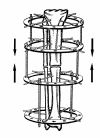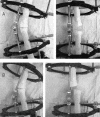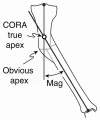Ilizarov principles of deformity correction
- PMID: 20353638
- PMCID: PMC3025247
- DOI: 10.1308/003588410X12518836439326
Ilizarov principles of deformity correction
Abstract
Ilizarov frames provide a versatile fixation system for the management of bony deformities, fractures and their complications. The frames give stability, soft tissue preservation, adjustability and functionality allowing bone to realise its full osteogenic potential. It is important that we have a clear and concise understanding of the Ilizarov principles of deformity correction to best make use of this fixation system. In this review article, the history of Ilizarov frame, the basic sciences behind it, the mechanical principles governing its use and the clinical use of the fixation system are discussed.
Figures




References
-
- Ilizarov GA, Ledyasev VI, Shitin VP. Experimental studies of bone lengthening. Eksp Khir Anesteziol. 1969;14:3. - PubMed
-
- Ilizarov GA. The tension-stress effect on the genesis and growth of tissues: Part I. The influence of stability of fixation and sort tissue preservation. Clin Orthop. 1989;238:249–81. - PubMed
-
- Ilizarov GA. The tension-stress effect on the genesis and growth of tissues: Part II. The influence of the rate and frequency of distraction. Clin Orthop. 1989;239:263–85. - PubMed
-
- Ilizarov GA. Clinical application of the tension-stress effect for limb lengthening. Clin Orthop. 1990;250:8–26. - PubMed
-
- Codivilla A. On the means of lengthening in the lower limbs, the muscles and tissues which are shortened through deformity. Am J Orthop Surg. 1905;2:353–69.
Publication types
MeSH terms
LinkOut - more resources
Full Text Sources
Other Literature Sources

